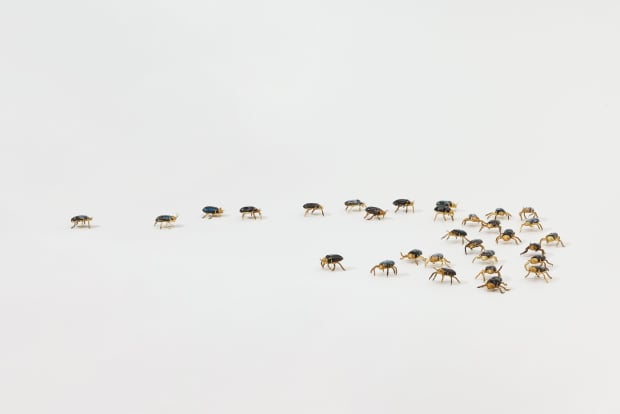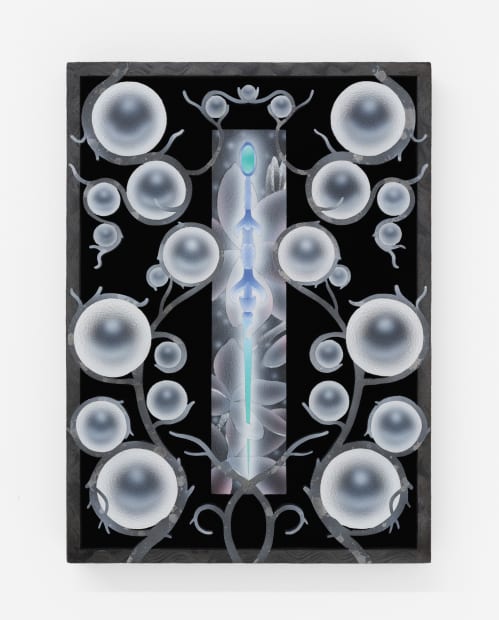-
 Elizabeth Jaeger 伊丽莎白·耶格Bird 鸟, 2023ceramic, bronze 陶瓷,青铜16 x 8 x 7 cm
Elizabeth Jaeger 伊丽莎白·耶格Bird 鸟, 2023ceramic, bronze 陶瓷,青铜16 x 8 x 7 cm
6 1/2 x 3 x 3 in -
 Feng Chen 冯晨Chronophobic Light 双重现实, 2025camera, LED light bulbs, light stands, programming RGB controller, HDMI switcher 摄像机,LED灯泡,灯架,RGB程序控制器,HDMI导播台dimension variable 尺寸可变Feng Chen's site-specific installation Chronophobic Light (2025) extends on his on-going series “The Darker Side of Light“, testifying to the artist's acute observation of the gap between perception and reality. Using technology to surgically remove the “presentness” of light and shadow, Feng Chen investigates how documentary mediums can demolish and reconstruct reality. When the camera fails to capture the dynamic luminance visible to the naked eye, this "dual reality" raises questions about the authenticity of sensory experience, and points out the rupture between experience and truth in the digital age. The viewer’s body becomes the medium that connects the two dimensions. Alternating between active observation and passive reception, the viewer re-examines how technology shapes and constrains human perception.Feng Chen creates videos, sculptures and hypnotic installations that investigate the synchronization between visuals and audio, inserting a wedge between different signals and leading us to question which of our senses we should ultimately trust. In his work, perception and reality interact with each other in labyrinthine ways reclaiming that experience is the most essential and authentic part of existence and the ultimate nature of reality.
Feng Chen 冯晨Chronophobic Light 双重现实, 2025camera, LED light bulbs, light stands, programming RGB controller, HDMI switcher 摄像机,LED灯泡,灯架,RGB程序控制器,HDMI导播台dimension variable 尺寸可变Feng Chen's site-specific installation Chronophobic Light (2025) extends on his on-going series “The Darker Side of Light“, testifying to the artist's acute observation of the gap between perception and reality. Using technology to surgically remove the “presentness” of light and shadow, Feng Chen investigates how documentary mediums can demolish and reconstruct reality. When the camera fails to capture the dynamic luminance visible to the naked eye, this "dual reality" raises questions about the authenticity of sensory experience, and points out the rupture between experience and truth in the digital age. The viewer’s body becomes the medium that connects the two dimensions. Alternating between active observation and passive reception, the viewer re-examines how technology shapes and constrains human perception.Feng Chen creates videos, sculptures and hypnotic installations that investigate the synchronization between visuals and audio, inserting a wedge between different signals and leading us to question which of our senses we should ultimately trust. In his work, perception and reality interact with each other in labyrinthine ways reclaiming that experience is the most essential and authentic part of existence and the ultimate nature of reality. -
 Peggy Chiang 江佩WITHOUT BREAK WITH ALL POWER 全速前进, 2024steel, cast aluminum, spoons, hardware, magnets 钢,铸铝,汤勺,五金配件,磁铁48.3 x 20.3 x 16.5 cm
Peggy Chiang 江佩WITHOUT BREAK WITH ALL POWER 全速前进, 2024steel, cast aluminum, spoons, hardware, magnets 钢,铸铝,汤勺,五金配件,磁铁48.3 x 20.3 x 16.5 cm
19 x 8 x 6 1/2 in -
 Peggy Chiang 江佩Forming 形成, 2024aluminum foil pan and plastic lid, UV resin, enamel paint, plywood, stained tablecloth 铝箔餐盒,塑料盒盖,紫外线固化树脂,搪瓷漆,胶合板,有污渍的桌布45.7 x 35.6 x 19.7 cm
Peggy Chiang 江佩Forming 形成, 2024aluminum foil pan and plastic lid, UV resin, enamel paint, plywood, stained tablecloth 铝箔餐盒,塑料盒盖,紫外线固化树脂,搪瓷漆,胶合板,有污渍的桌布45.7 x 35.6 x 19.7 cm
18 x 14 x 8 in -
 Elizabeth Jaeger 伊丽莎白·耶格Rat 老鼠, 2024ceramic, bronze 陶瓷,青铜10.8 x 10.2 x 33 cm
Elizabeth Jaeger 伊丽莎白·耶格Rat 老鼠, 2024ceramic, bronze 陶瓷,青铜10.8 x 10.2 x 33 cm
4 1/2 x 4 x 13 in -
 Alessandro Teoldi 亚历山德罗·泰尔迪Cuscino 枕, 2024oil and linen collage mounted on linen 油画、亚麻拼贴覆于亚麻布上27.9 x 35.6 cm
Alessandro Teoldi 亚历山德罗·泰尔迪Cuscino 枕, 2024oil and linen collage mounted on linen 油画、亚麻拼贴覆于亚麻布上27.9 x 35.6 cm
11 x 14 in -
 Alessandro Teoldi 亚历山德罗·泰尔迪Still Life 静物, 2022terracotta 赤陶47 x 34 x 2.5 cm
Alessandro Teoldi 亚历山德罗·泰尔迪Still Life 静物, 2022terracotta 赤陶47 x 34 x 2.5 cm
18 1/2 x 13 1/2 x 1 in -
 Tao Siqi 陶斯祺Savoring 品尝, 2025oil on canvas 布面油画60 x 90 cm
Tao Siqi 陶斯祺Savoring 品尝, 2025oil on canvas 布面油画60 x 90 cm
23 1/2 x 35 1/2 in“Savoring” (2025) is a recently created signature artwork by Tao Siqi. In this piece, Tao continues her exploration into themes such as desire, intimacy, dependence, violence, and destruction. With a compassionate gaze, she examines the complexity of human emotions and desires, portraying them with a rare sense of empathy, and redefining notions of taboo and eroticism into a prism that refracts our physical and emotional experiences. Through her delicate brushstrokes and using intimate close-ups of subject, Tao captures moments that oscillate between tenderness and struggle.
In “Savoring”, a figure cradles a bare foot and kisses it — an act that conveys an intoxicating obsession, tinged with an unspoken yearning for possession. The fluorescent green glow dominating the scene and the snake coiling below add a surreal, enigmatic presence, drawing viewers into a fluid and charged emotional landscape she crafts.
Tao Siqi's paintings are rooted in her fascination with the body and flesh as a medium of sensibility and sexuality. She delves into desire of all forms through her intense colors, delicate brushstrokes and characteristic close-up perspective. By creating a tension between beauty and destruction, tenderness and violence, temptation and taboo, her surreal scenes inspire a provocative viewing experience and conjure emotional unease, flickering between pleasure and pain.
-
 Tao Siqi 陶斯祺Snare 陷阱, 2025oil on canvas 布面油画25 x 30 cm
Tao Siqi 陶斯祺Snare 陷阱, 2025oil on canvas 布面油画25 x 30 cm
10 x 12 in -
 Leelee Chan 陳麗同Shapeshifter (Volva) 变型体(梭螺), 2025hand-carved China black granite and CNC-milled stainless steel 中国黑花岗岩石,CNC铣削不锈钢114 x 29 x 21 cm
Leelee Chan 陳麗同Shapeshifter (Volva) 变型体(梭螺), 2025hand-carved China black granite and CNC-milled stainless steel 中国黑花岗岩石,CNC铣削不锈钢114 x 29 x 21 cm
45 x 11 1/2 x 8 1/2 inInterplaying their diverse physical properties and cultural meanings, Chan continues her investigation of materiality and layered temporality through her astute sensitivity to material objects and her deep reverence for process. In Spiral Diaries, the recurring motifs of natural forms, mollusks, plants, and whelk egg cases probe her perpetual fascination with the unsettling metamorphosis of the natural world, particularly the mollusk’s supreme resilience and their ability to shapeshift by reconfiguring and repurposing individual body parts through natural selection for billions of years.As shell-makers, mollusks are architects that have turned calcium carbonate in the seawater into ceramic spirals whose afterlife has penetrated human civilization since prehistoric times. Biologists suggest that mollusks can read the patterns on their spiral shells as though they were diary entries, a vital element for their memory and orientation before continuing their construction. In this way, the patterns become a collection of memories etched across their shells, almost like a depiction of movement through time without a complete final image.Instead of a juxtaposition, Chan's sculptures propose rather a form of composition that encompasses multiple stages of the same material history, thus reflecting the entanglement with the more-than-human world and proposing an alternative way of thinking and learning from other forms of intelligence. In doing so, they underline the irreversible modifications of morphology caused by human decisions as they question the fundamental notion of progress and development, ultimately offering an alternative view of the Western constructs of human-centric advancement and growth. -

-
 Nicki Cherry 尼基·切里Holding Pattern 悬而未决, 2025fiberglass-reinforced gypsum cement, concrete pigment, stainless steel hardware, blister pearls 玻璃纤维增强石膏水泥、混凝土颜料、不锈钢配件、翳珠124.5 x 51 x 30.5 cm
Nicki Cherry 尼基·切里Holding Pattern 悬而未决, 2025fiberglass-reinforced gypsum cement, concrete pigment, stainless steel hardware, blister pearls 玻璃纤维增强石膏水泥、混凝土颜料、不锈钢配件、翳珠124.5 x 51 x 30.5 cm
49 x 20 x 12 in -
 Alessandro Teoldi 亚历山德罗·泰尔迪Hug 拥抱, 2023bronze 青铜16 x 9 cm
Alessandro Teoldi 亚历山德罗·泰尔迪Hug 拥抱, 2023bronze 青铜16 x 9 cm
6 1/2 x 3 1/2 in -
 Tian Jianxin 田建新Eye Drops 眼药水, 2024aluminium lid 铝炖锅盖16 x 16 x 6 cm
Tian Jianxin 田建新Eye Drops 眼药水, 2024aluminium lid 铝炖锅盖16 x 16 x 6 cm
6 1/2 x 6 1/2 x 2 1/2 in -
 Sarah Faux 莎拉·福克斯More 更多, 2022oil on canvas 布面油画55.9 x 50.8 cm
Sarah Faux 莎拉·福克斯More 更多, 2022oil on canvas 布面油画55.9 x 50.8 cm
22 x 20 in -
 Wang Haiyang 王海洋Human Beast Ghost 人鬼兽, 2023watercolour on paper 纸本水彩51 x 35.5 cm; 20 x 14 in
Wang Haiyang 王海洋Human Beast Ghost 人鬼兽, 2023watercolour on paper 纸本水彩51 x 35.5 cm; 20 x 14 in
57.5 x 41.7 cm; 22 1/2 x 16 1/2 in (framed 含框) -
 Douglas Rieger 道格拉斯·莱杰Invisible Dragon (Int.Strain) 不可见之龙(内部张力), 2025wood, paint, aluminum, steel, hardware 木材,颜料,铝,钢,五金配件Sculpture 主体: 81.3 x 81.3 x 152.4 cm; 32 x 32 x 60 in
Douglas Rieger 道格拉斯·莱杰Invisible Dragon (Int.Strain) 不可见之龙(内部张力), 2025wood, paint, aluminum, steel, hardware 木材,颜料,铝,钢,五金配件Sculpture 主体: 81.3 x 81.3 x 152.4 cm; 32 x 32 x 60 in
Base 底座: 139.7 x 139.7 x 76.2 cm; 55 x 55 x 30 inInvisible Dragon (Int. Strain) (2025) by Douglas Rieger is a striking sculptural work that juxtaposes industrial strength with organic fluidity. The piece features a robust steel base, providing a solid foundation for the large sculptural form resting atop it. This upper structure, with its undulating contours and evocative physicality, suggests a dynamic interplay between tension and release.This sculpture functions as a tool, embodying a process-driven approach rather than one dictated by a preconceived idea or opinion. For the artist, the form comes first, leading the way, while meaning and ideas emerge in response. Unlike traditional methods where an idea precedes the object, here, the act of making generates thought.While rooted in drawing, the final work diverges significantly from its initial sketches. The connection between the two develops organically during the sculpting process, shaped by trial, error, and the essential role of the artist’s direct engagement with the material. Flawed logic and mistakes become integral elements of the work’s evolution.This sculpture is both personal and open-ended—it holds traces of an encounter with decaying industrial equipment near the artist’s childhood home, a past relationship, and places that once sparked excitement. It exists as an abstracted form, a vessel for projection and interpretation, allowing both artist and viewer to find meaning within it.Like fire or music, sculpture resists full capture. A photograph can never fully convey its presence; movement is lost, shape shifts, and experience changes. It harbors a secret, one that can only be uncovered through direct engagement—by being in its presence. -
 Young-jun Tak 卓永俊My Projection 我的投射, 2024lime wood, brass, beeswax 椴木、黄铜、蜂蜡25.3 x 11 x 10.8 cm
Young-jun Tak 卓永俊My Projection 我的投射, 2024lime wood, brass, beeswax 椴木、黄铜、蜂蜡25.3 x 11 x 10.8 cm
10 x 4 1/2 x 4 1/2 inEdition of 5 plus 1 artist's proof -
 Wang Haiyang 王海洋Blue Dream, Red Midsummer Night 蓝色梦魇与红色仲夏夜, 2023acrylic on canvas 布面丙烯80 x 80 cm
Wang Haiyang 王海洋Blue Dream, Red Midsummer Night 蓝色梦魇与红色仲夏夜, 2023acrylic on canvas 布面丙烯80 x 80 cm
31 1/2 x 31 1/2 in -
 Leelee Chan 陳麗同Ode to Hilma 致希尔玛, 2024found polystyrene foams, powder-coated metal lampshade, dried coral, stainless steel wheels, epoxy clay, pigment, modified gypsum composite 拾得聚苯乙烯泡沫,粉末喷涂金属灯罩,干珊瑚,不锈钢转轮,环氧粘土,颜料,改性石膏复合材料74 x 62 x 25 cm
Leelee Chan 陳麗同Ode to Hilma 致希尔玛, 2024found polystyrene foams, powder-coated metal lampshade, dried coral, stainless steel wheels, epoxy clay, pigment, modified gypsum composite 拾得聚苯乙烯泡沫,粉末喷涂金属灯罩,干珊瑚,不锈钢转轮,环氧粘土,颜料,改性石膏复合材料74 x 62 x 25 cm
29 x 24 1/2 x 10 in -
 Elizabeth Jaeger 伊丽莎白·耶格Beetles 甲壳虫, 2024ceramic, brass 陶瓷,黄铜Set of 30 pcs; dimensions variable 一组30个,尺寸可变
Elizabeth Jaeger 伊丽莎白·耶格Beetles 甲壳虫, 2024ceramic, brass 陶瓷,黄铜Set of 30 pcs; dimensions variable 一组30个,尺寸可变 -
 Elizabeth Jaeger 伊丽莎白·耶格Rail (Polly) 围栏(波莉), 2024steel, ceramic, brass 钢,陶瓷,黄铜94.6 x 117.2 x 92.7 cm
Elizabeth Jaeger 伊丽莎白·耶格Rail (Polly) 围栏(波莉), 2024steel, ceramic, brass 钢,陶瓷,黄铜94.6 x 117.2 x 92.7 cm
37 1/4 x 46 1/8 x 36 1/2 in -
 Elizabeth Jaeger 伊丽莎白·耶格Rail (Flaco) 围栏(弗拉科), 2024ceramic, bronze 陶瓷,青铜owl 猫头鹰: 45.7 x 21.6 x 22.9 cm; 18 x 8 1/2 x 9 in
Elizabeth Jaeger 伊丽莎白·耶格Rail (Flaco) 围栏(弗拉科), 2024ceramic, bronze 陶瓷,青铜owl 猫头鹰: 45.7 x 21.6 x 22.9 cm; 18 x 8 1/2 x 9 in
stand 底座: 18.8 x 26.3 x 22.5 cm; 7 1/2 x 10 1/2 x 9 in
fence 栅栏: 121.7 x 248.5 x 122.5 cm; 48 x 98 x 48 in -
 Elizabeth Jaeger 伊丽莎白·耶格Rat 老鼠, 2024ceramic, bronze 陶瓷,青铜17.8 x 11.4 x 24.1 cm
Elizabeth Jaeger 伊丽莎白·耶格Rat 老鼠, 2024ceramic, bronze 陶瓷,青铜17.8 x 11.4 x 24.1 cm
7 x 4 1/2 x 9 1/2 in -
 Elizabeth Jaeger 伊丽莎白·耶格Rat 老鼠, 2024ceramic, bronze 陶瓷,青铜10.2 x 29.2 x 10.2 cm
Elizabeth Jaeger 伊丽莎白·耶格Rat 老鼠, 2024ceramic, bronze 陶瓷,青铜10.2 x 29.2 x 10.2 cm
4 x 11 1/2 x 4 in -
 Tian Jianxin 田建新Kidney (front) 腰子正, 2022aluminium lid 铝盖18 x 5 x 10 cm
Tian Jianxin 田建新Kidney (front) 腰子正, 2022aluminium lid 铝盖18 x 5 x 10 cm
7 x 2 x 4 in -
 Tian Jianxin 田建新Sideburn 鬓, 2024Japanese aluminium bottle日本铝水壶11 x 6 x 18 cm
Tian Jianxin 田建新Sideburn 鬓, 2024Japanese aluminium bottle日本铝水壶11 x 6 x 18 cm
4 1/2 x 2 1/2 x 7 in -
 Luca Campestri 卢卡·坎佩斯特里The dreamer slept but did not dream 梦者沉睡却未曾做梦, 2024direct printing on retro-reflective fabric 直接印刷于反光织物18 x 24 cm
Luca Campestri 卢卡·坎佩斯特里The dreamer slept but did not dream 梦者沉睡却未曾做梦, 2024direct printing on retro-reflective fabric 直接印刷于反光织物18 x 24 cm
7 x 9 1/2 in -
 Luca Campestri 卢卡·坎佩斯特里The dreamer slept but did not dream 梦者沉睡却未曾做梦, 2024direct printing on retro-reflective fabric 直接印刷于反光织物18 x 24 cm
Luca Campestri 卢卡·坎佩斯特里The dreamer slept but did not dream 梦者沉睡却未曾做梦, 2024direct printing on retro-reflective fabric 直接印刷于反光织物18 x 24 cm
7 x 9 1/2 in -
 Chris Oh 克里斯·吴Shattered 碎裂, 2024acrylic on geode 紫晶洞上丙烯设色10.8 x 13.3 x 10.8 cm
Chris Oh 克里斯·吴Shattered 碎裂, 2024acrylic on geode 紫晶洞上丙烯设色10.8 x 13.3 x 10.8 cm
4 1/4 x 5 1/4 x 4 1/4 in -
 Chris Oh 克里斯·吴Deluge 大洪水, 2025acrylic on seashell 贝壳上丙烯设色17.1 x 13.3 x 5.1 cm
Chris Oh 克里斯·吴Deluge 大洪水, 2025acrylic on seashell 贝壳上丙烯设色17.1 x 13.3 x 5.1 cm
7 x 5 1/2 x 2 in -
 Alice Wang 王凝慧Untitled 无题, 2025silver leaf, UV light fluorescent pink pigment, resin 银箔,紫外线荧光粉色颜料,树脂13.25 x 10.5 x 9 cm
Alice Wang 王凝慧Untitled 无题, 2025silver leaf, UV light fluorescent pink pigment, resin 银箔,紫外线荧光粉色颜料,树脂13.25 x 10.5 x 9 cm
5 x 4 x 3 1/2 in -
 Alice Wang 王凝慧Untitled 无题, 2025salt, resin 盐,树脂9 x 13 x 11 cm
Alice Wang 王凝慧Untitled 无题, 2025salt, resin 盐,树脂9 x 13 x 11 cm
3 1/2 x 5 x 4 1/2 in -
 Bryson Rand 布莱森·兰德Rain on Lake 湖上雨, 2023 (printed 2024)pigment print 喷墨打印71.1 x 53.3 cm; 74 x 56.5 cm (framed 含框)
Bryson Rand 布莱森·兰德Rain on Lake 湖上雨, 2023 (printed 2024)pigment print 喷墨打印71.1 x 53.3 cm; 74 x 56.5 cm (framed 含框)
28 x 21 in; 29 x 22 in (framed 含框)Edition of 3 plus 1 artist's proof -
 Bryson Rand 布莱森·兰德Chain/Shadows 锁链/阴影, 2023 (printed 2024)pigment print 喷墨打印71.1 x 50.8 cm; 74 x 53.5 cm (framed 含框)
Bryson Rand 布莱森·兰德Chain/Shadows 锁链/阴影, 2023 (printed 2024)pigment print 喷墨打印71.1 x 50.8 cm; 74 x 53.5 cm (framed 含框)
28 x 20 in; 29 x 21 in (framed 含框)Edition of 3 plus 1 artist's proof -
 Bryson Rand 布莱森·兰德Tony's Back 托尼的背, 2023 (printed 2024 印相于2024)pigment print 喷墨打印71.1 x 50.8 cm; 74 x 53.5 cm (framed 含框)
Bryson Rand 布莱森·兰德Tony's Back 托尼的背, 2023 (printed 2024 印相于2024)pigment print 喷墨打印71.1 x 50.8 cm; 74 x 53.5 cm (framed 含框)
28 x 20 in; 29 x 21 in (framed 含框)Edition of 3 plus 1 artist's proof -
 Maya Kramer 玛雅·克莱默Grey Zone 灰色地带, 2018Aluminum, enamel, plexiglass, pump, fans, water 铝、搪瓷、有机玻璃、泵、风扇、水
Maya Kramer 玛雅·克莱默Grey Zone 灰色地带, 2018Aluminum, enamel, plexiglass, pump, fans, water 铝、搪瓷、有机玻璃、泵、风扇、水
100.5 x 70 x 15.5 cm
Edition of 3 plus 1 artist's proof -
 Elizabeth Jaeger 伊丽莎白·耶格Sudden footsteps 突如其来的脚步声, 2024ceramic 陶瓷16.5 x 48.3 x 48.3 cm
Elizabeth Jaeger 伊丽莎白·耶格Sudden footsteps 突如其来的脚步声, 2024ceramic 陶瓷16.5 x 48.3 x 48.3 cm
6 1/2 x 19 x 19 in -
 Mevlana Lipp 梅夫拉纳·利普Needle 针, 2025wood, velvet, acrylic color, ink, sand, aluminum stretcher 木材,天鹅绒,丙烯颜料,墨水,沙粒,铝制画框45 x 33 x 4 cm
Mevlana Lipp 梅夫拉纳·利普Needle 针, 2025wood, velvet, acrylic color, ink, sand, aluminum stretcher 木材,天鹅绒,丙烯颜料,墨水,沙粒,铝制画框45 x 33 x 4 cm
17 1/2 x 13 x 1 1/2 in
Capsule Filling : Pop-up at Hilltop Plaza, Hong Kong - Curated by Zoie Yung
Past viewing_room











































